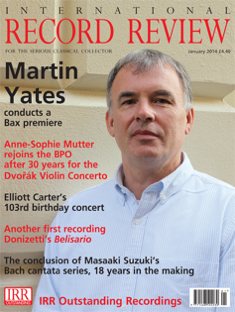Texte paru dans: / Appeared in: |
|
|
Reviewer: Christopher Price This is the sixteenth disc in Alia Vox’s ‘ Heritage Series ’ reissuing the recordings made by Jordi Savall and his ensemble Hespèrion XX for the Astrée label in the 1980s and 1990s. There are no musical additions to the original programme and the booklet provides Savall’s original notes, giving a detailed account of the little that is known about Diego Ortiz and an informative description of the music from his Trattado de Glosas of 1553. The bonus, besides the glossy new packaging, is that this hybrid SACD contains not only the original standard CD recording but also two high-resolution versions in DSD format, one stereo and the other multi-channel. The stereo DSD version, which can be played only on a dedicated SACD player, certainly sounds more detailed and airier than the already impressively sound- engineered original CD version, with the balance between Savall’s solo viol and the accompanying instruments benefiting especially from the new format. As with earlier discs in the ‘ Heritage Series ‘ , the surround-sound effects (or front centre and two rear speaker tracks) on the multi-channel version have been synthesized from the original stereo CD recording by Alia Vox’s engineer Manuel Mohino. Not having a multi-channel set-up in my hi-fi system, I cannot say how convincing it sounds. The performances certainly remain utterly convincing. Since its original appearance in 1990, Savall’s recording (his second after a less accomplished account for Hispavox in 1970) has remained the ‘classic’ account of the music from Ortiz’s Trattado de Glosas, which the Toledan viol virtuoso published in Rome instead of his native Castile (hence the misprint of the Spanish ‘tratado ‘ with a double ‘t’). It would be difficult to make this music sound less than captivating, of course. Despite their didactic purpose of illustrating Ortiz’s technical explanations of how to ornament and improvise variations, these pieces have considerable musical interest, especially the set of recercadas (in effect fantasias) on the basse-danse La Spagna and nine recercadas on a selection of toe-tapping Italian grounds, including La Romanesca and La Follia , which remained immensely popular with composers of the next two generations after Ortiz. While, in the two rival recordings from the 1990s, Philippe Foulon and Bettina Hoffmann are as technically assured as Savall, he outstrips them in terms of sheer style, thanks largely to the extreme refinement of his playing and ability to evoke a huge range of colours from his instrument. Even the trickiest passages he delivers with an insouciant-seeming flair, avoiding overt virtuosity and overt mannerism in favour of subtle phrasing, fluid rhythms and opulent textures. His accompanists also have the edge over Foulon’s Lachrimae Consort and Hoffmann’s Modo Antiquo, both otherwise excellent, especially the ebullient and inventive Ton Koopman on a brilliant-sounding harpsichord and a soft-edged positive organ. In her incomplete recording (for reasons she does not explain, she plays only 16 of the 27 recercadas in the collection), Masako Hirao, a frequent collaborator with Savall and stylistically closer to him than the others, presents him with a real challenge by the elegance of her playing and the sophistication of the realizations of her all-Japanese accompanists. Like Modo Antiquo , her colleagues include four extra Renaissance viol players for the recercadas demonstrating viol consort diminutions; but she also introduces unwanted percussion from time to time. Savall is joined by a single bass viol and violone (Paolo Pandolfo and Lorenz Duftschmid and relies on the plucked strings and keyboard to make up the remaining parts of certain pieces. Confined solely to the 27 recercadas of the collection, the playing time of Savall’s disc is very short indeed at 49 minutes and 39 seconds. Hoffmann and Hirao have a vocal ensemble sing Pierre Sandrin’s original Doulce Memoire and Jacques Arcadelt’s O Felici Occhi Miei, while Foulon’s outstanding harpsichordist, Emer Buckley, provides attractive basically unornamented keyboard intabulations of these two works to i the variations on them. While a good idea and adding about ten minutes of music, this is not necessary for the full enjoyment of Ortiz’s music. Hoffmann extends her programme to over an hour by adding also all the musical examples for bass instrument from the Italian flautist Silvestro di Ganassi’s earlier published treatises on ornamentation, La Regola Rubertina (1542) and La Fontegara (1543). Hirao (whose disc also benefits from excellent sound engineering) supplements the 16 recercadas she performs with five vocal works, including an Ave Maris Stella, a Salve Regina and a Magnificat from Ortiz’s only other publication, a collection of polyphony for the Divine Office (mainly Vespers) entitled Liber primus, published in Venice in 1565 . Her highly accomplished Japanese singers fascinatingly ornament their lines in these works written around plainchant cantus firmus using formulas derived from the Trattado de Glosas. Owing to all this, in addition to her own superb playing, Hirao’s disc gives Savall’s a real run for its money. However, for me Savall’s version still remains supreme.
|
|
|
|
|
|
Cliquez l'un ou l'autre
bouton pour découvrir bien d'autres critiques de CD |
|




